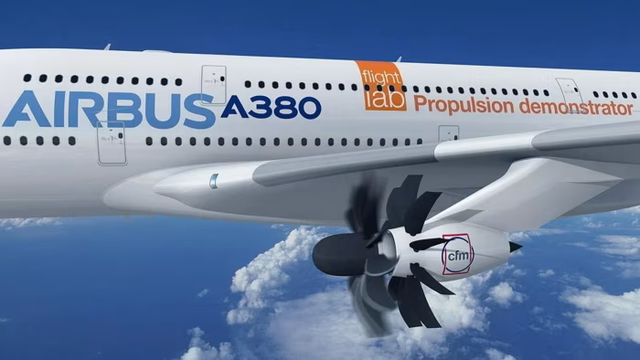Science
Related: About this forumAirbus to test radical engine design for successor to A320
Yeah, Radical.

FT archived.
https://archive.is/gGX1h#selection-1695.0-1695.58
The European aerospace and defence group said test flights of a demonstrator of the “open fan” engine would take place on a modified A380 superjumbo towards the end of this decade.
...
Airbus is working with CFM International, a joint venture between GE Aerospace of the US and France’s Safran, on the open fan jet engine.
Mohamed Ali, chief technology and operations officer of GE Aerospace, told the Financial Times the companies were already working with regulators on issues around the new design. They included how to address higher noise levels from the open fan and any safety concerns.
I double-checked.
So check out the leadership of G.E. Aerospace now.
https://www.geaerospace.com/company/about-us/leadership
G.E. Aircraft Engine Group was my first job out of the service.
Uneventful other than cutting the shaft on an A-10 TF-34 jet engine operating at full speed with a high power laser to test the overspeed controls, and the boss dropping in on a mid-morning goof-off session of managers at a nearby restaurant. Got a chuckle out of that one.
Days of Kim-1 and MC6800 computers. My goodness.
OAITW r.2.0
(30,865 posts)Kinda makes a lot of sense. Don't know how that relates to airspeed, though. Longer flight times?
usonian
(22,009 posts)Possibly except for fighter jets.
Hugin
(37,043 posts)But, hey, I am all for basic research if they have the money.
Howard Hughes would approve. He hated jets.
usonian
(22,009 posts)It's a combination. Props alone don't have the combustive thrust.
This is pretty easy to grasp.
https://pilotinstitute.com/turbofan-vs-turbojet/
And more complex:
https://www.century-of-flight.net/turbojet-vs-turbofan-explained/
Hmmmm. Interesting.
Hugin
(37,043 posts)I was questioning the efficiency of turbo-props vs turbo-fans. The only difference between the two is that turbo-props are connected to the shaft of a jet via a mechanical linkage rather than directly to the shaft as a turbo-fan is.
This article says that both props and fans are more efficient than a jet alone. Although, I would guess that there is some more loss in the mechanical linkage of a prop than in a fan.
https://www.boldmethod.com/learn-to-fly/systems/the-4-types-of-turbine-engines/
A pretty good article, by the way.
Hughes’ objection to jets was actually well founded. He argued that jets are only efficient at high altitudes and speeds. A part of a flight envelope that commercial airliners spend little time, if they enter them at all on shorter routes. He kept props (even though they were the ridiculous high-maintenance dozens of cylinder rotaries) until they stopped being produced. He was okay with turbo-props on helicopters and even automobiles. Of course, turbo-fans were decades away from being developed. They came into their own during the fuel crisis of the 1970’s and due to noise issues with turbo-jets at busy airports. So, like you said, mostly efficiency.
muriel_volestrangler
(105,102 posts)and often contra-rotating fans. The swept blades are credited with the better efficiency at speeds higher than a turboprop can achieve:
https://en.wikipedia.org/wiki/Propfan

The FT illustration looks more like one rotating fan in front of a static set of blades; or maybe that's meant to show a fast fan in front of a slow one.
The thrust from the exhaust is still notable for a turbofan, and I guess a propfan.
I believe the Soviet Bear turboprop, with contra-rotating propellors, is infamously noisy; I wonder if these open rotor engines would suffer from that too.
Hugin
(37,043 posts)That noise will be one of the focal points of the study.
Most fans that I have ever seen are straight. Which is very noisy due to the supersonic turbulence at the tips of the blades. Hence, why they are ensconced in a shroud or cover. The article says that these covers are also there for safety. Should a fan blade fail. A concept that made me chuckle a bit. Nothing in an airworthy airframe is going to stop a failed fan blade.
I believe that I have read some of the supersonic blade tip noise can also be reduced by aerodynamic shaping of the blades. Which is illustrated. There’s a price to be paid in efficiency by doing so. Also, as you say contra rotation or even stationary blades behind the fan could possibly help with the turbulence and reduce the noise.
Interesting plot you posted. ![]()
LastDemocratInSC
(4,170 posts)I remember those well. I still have a Motorola D2 evaluation kit that works. Those systems set me on the path I've taken in life.
usonian
(22,009 posts)Projects end and labs just toss stuff. Called dumpster diving.
I will probably shadow-box some stuff. Benefit of being single.
IMSAI was next. Opened many doors.
Sure was fun.